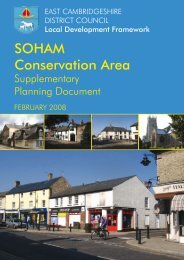East Cambridgeshire District Council Water Cycle Study Detailed ...
East Cambridgeshire District Council Water Cycle Study Detailed ...
East Cambridgeshire District Council Water Cycle Study Detailed ...
Create successful ePaper yourself
Turn your PDF publications into a flip-book with our unique Google optimized e-Paper software.
Stage 2 <strong>Water</strong> <strong>Cycle</strong> <strong>Study</strong>: Final Report<br />
Sept 2011<br />
2<br />
<strong>Cambridgeshire</strong> Horizons<br />
<strong>East</strong> <strong>Cambridgeshire</strong> – <strong>Detailed</strong> WCS<br />
hence growth should not be seen as a barrier to watercourses in the <strong>District</strong> meeting ‘Good Status’ in the<br />
future.<br />
Ecological impacts on Designated Sites<br />
There are three statutory designated sites which were identified in the outline WCS as being connected to<br />
WwTW discharges in <strong>East</strong> <strong>Cambridgeshire</strong> – Wicken Fen SAC/Ramsar site/SSSI/LNR, Ouse Washes<br />
SAC/SPA/Ramsar site/SSSI and Cam Washes SSSI. There is one County Wildlife Site (New River/Monks<br />
Lode) which is linked to a wastewater treatment works.<br />
Wicken Fen SAC/Ramsar site/SSSI/Local Nature Reserve<br />
Burwell WwTW discharges to the Catchwater Drain which itself drains to Burwell Lode. Wicken Lode flows<br />
into Burwell Lode at the south-west corner of Wicken Fen. It is theoretically possible for water to backflow<br />
from Burwell Lode into Wicken Lode, but the EA in their RoC considered this a low eventuality. There is<br />
thus no evidence on which to conclude that discharges to Burwell Lode associated with the increase in<br />
discharges from Burwell WwTW will have any impact on Wicken Lode or Wicken Fen.<br />
Cam Washes SSSI<br />
Burwell Lode joins Reach Lode approximately 1km upstream of the River Cam which is the watercourse<br />
into which Reach Lode drains. The Cam Washes are offline meadows which depend upon seasonal<br />
inundation from the River Cam to maintain their ornithological interest. Burwell and Bottisham WwTW’s will<br />
both require changes (or a new solution) to their discharge consents to ensure ‘no deterioration’ in the<br />
quality of the receiving watercourses as a result of the increased discharge volumes from each WwTW.<br />
However, given that Burwell WwTW and Bottisham WwTW make a relatively small contribution to<br />
phosphorus loads in the downstream River Cam, it is reasonable to conclude that the upgrades necessary<br />
to achieve ‘no deterioration’ in the receiving watercourse should adequately address the WwTW’s<br />
individual contribution to phosphorus loading in the River Cam.<br />
New River/Monks Lode County Wildlife Site<br />
Monks Lode contains a number of fish species including spined loach, bitterling, bream, dace, eel, perch,<br />
roach and pike. The Outline <strong>Water</strong> <strong>Cycle</strong> <strong>Study</strong> identified a potential connection between discharges of<br />
Burwell WwTW and the New River via Catchwater Drain which is the receiving watercourse for the WwTW.<br />
Further scrutiny for the <strong>Detailed</strong> WCS has identified that the prevailing direction of flow will in fact prevent<br />
significant backflow into the New River and there is thus no evidence of a connection between Burwell<br />
WwTW and Monks Lode.<br />
Ouse Washes SAC/SPA/Ramsar site/SSSI<br />
The EA RoC process concluded in the Stage 4 Report that ‘the water quality in the Hundred Foot Drain is<br />
dominated by the water quality upstream of Earith in the Bedford Ouse Catchment. Phosphate<br />
concentrations do not increase along the course of the Hundred Foot River, suggesting that inputs from the<br />
STWs in the <strong>East</strong> <strong>Cambridgeshire</strong> study area are having little or no effect on water quality within this<br />
watercourse. In addition the connection between the Hundred Foot River and the designated SAC rivers is<br />
limited meaning water quality in the Hundred Foot River is unlikely to significantly influence the Old<br />
Bedford Ouse’. The RoC therefore ultimately concluded that there was no amendment required to the<br />
existing consents. The current evidence therefore does not indicate that existing phosphate discharges<br />
from the WwTWs in <strong>East</strong> <strong>Cambridgeshire</strong> are likely to be having an adverse effect upon the Ouse Washes<br />
SAC/SPA or SSSI.<br />
Before changes to the consents for relevant WwTWs are made, it is necessary to determine which<br />
WwTWs that discharge to tributaries of the Hundred Foot River are likely to require changes to their<br />
consented discharge volumes and quality standards and whether this will result in a change to the existing






